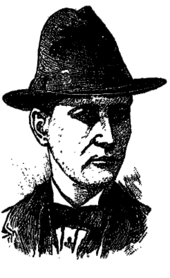Max Hödel
Emil Heinrich Max Hödel (born May 27, 1857 in Leipzig ; † August 16, 1878 in Berlin ), known as Lehmann , was a German assassin and at times a member of the SAPD and a member of the Christian Social Workers' Party founded by the imperial court preacher Adolf Stoecker .
Life
Hödel was a journeyman plumber and came from Leipzig. He became famous for an unsuccessful revolver assassination attempt on the German Emperor Wilhelm I on May 11, 1878 on Unter den Linden in Berlin .
Nobody was injured in the assassination attempt on the Kaiser, who was driving in an open carriage , as all the shots fired missed the Kaiser and did not hit anyone else. This assassination attempt on Wilhelm I triggered a storm of indignation throughout the empire and received a large echo in the press, where headlines such as The assassination attempt on His Majesty the German Emperor and The deed of a madman could be read.
Immediately after the crime, Hödel was arrested by policemen and sentenced to death by the Prussian State Court on July 10, 1878 for high treason . He was beheaded on August 16, 1878 in Berlin-Moabit prison by the executioner Julius Krautz . For this purpose, they had borrowed an old executioner's ax from the Märkisches Museum .
About Hödel's end of life it was said in the Cellesche Zeitung :
“'Come on,' said the executioner to Hödel. He literally jumped up the 3 steps to the sheepot and undressed at the top of his skirt and vest. At that moment the poor sinner's bell rang in the institution. Hödel looked up at this little bell with indescribable impudence and sneered at those present, then threw off his suspenders, but could not undo a button on his shirt, whereupon one of the executioner's assistants pulled it down from behind so that his upper body went over them Chest was exposed. The executioners' assistants then strapped the criminal by the arms and feet and laid his head face down in the incision in the block by strapping the back of the head with a hand-width belt so that the neck was exposed and the delinquent could not move his head . Now the executioner opened a clean case with the year 1878 in gold print on it, took the ax and cut the head from the body with one blow [...]. "
On June 2, 1878, only three weeks after Hödel's assassination attempt on the emperor, another assassination attempt also took place on Unter den Linden, in which Karl Eduard Nobiling seriously injured the emperor. Chancellor Otto von Bismarck used both acts as an opportunity to persecute social democracy through the socialist laws.
literature
- Uwe Winkler: From the museum to the scaffold. A little story of an ax. Berlin, Verlag M, 2009, ISBN 978-3-9812257-3-0
Web links
- German history in documents and pictures
- Official notice on Hödel's conviction: No. 29. Provincial Correspondence. Sixteenth year. July 17, 1878
- August Bebel: The Hödel attack and its consequences
Individual evidence
- ↑ Hödel, Max . In: Meyers Konversations-Lexikon . 4th edition. Volume 8, Verlag des Bibliographisches Institut, Leipzig / Vienna 1885–1892, pp. 603–603.
- ↑ Cellesche Zeitung of August 18, 1878, illustrated by Blazek, Matthias: Scharfrichter in Preußen und im Deutschen Reich 1866–1945, Stuttgart 2010, p. 30, ISBN 978-3-8382-0107-8 .
| personal data | |
|---|---|
| SURNAME | Hödel, Max |
| ALTERNATIVE NAMES | Hödel, Emil Heinrich Max (full name) |
| BRIEF DESCRIPTION | German assassin |
| DATE OF BIRTH | May 27, 1857 |
| PLACE OF BIRTH | Leipzig |
| DATE OF DEATH | August 16, 1878 |
| Place of death | Berlin |
